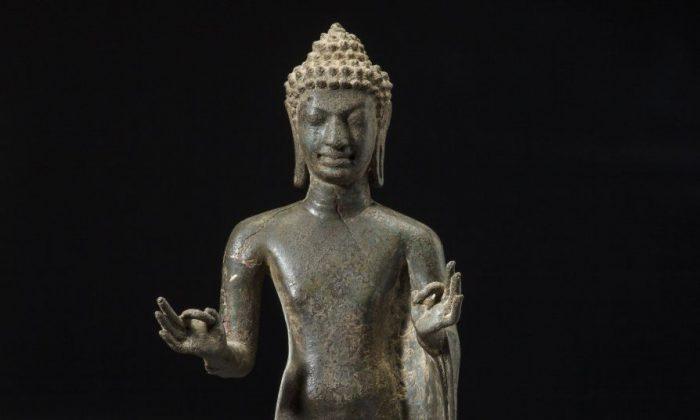NEW YORK—Asian art week is right around the corner, and New York auction houses are busy with preparations. As sale highlights are announced, collectors browse online catalogs for irresistible finds or investments.
Bonhams New York has announced three auctions, proudly boasting works from the estate of a well-respected Indian and Southeast Asian art scholar, Natasha Eilenberg, to lead their Himalayan, Indian and Southeast Asian sale on Sept. 11.
The auction house will also hold its Fine Chinese Painting and Calligraphy sale on Sept. 12 and its Fine Japanese Works of Art sale on Sept. 12.
Presale public viewing starts Sept. 8 and lasts until the day of the auctions at Bonhams in Midtown Manhattan.
One of the highlights is a copper-alloy Buddha figure from the Mon Dvaravati culture of Thailand (circa 7th to 8th century). The 19-inch-high Eilenberg Buddha is estimated at $250,000 to $350,000.
The Buddha will be of interest to international museums and collectors. It is “the most important Mon Dvaravati sculpture to have appeared in the market [in] recent years, and it could be argued that it is the finest example of its type still in private hands,” according to Bonhams.
Description From Bonhams
The Buddha is cast in the frontal position with both arms bent at the elbows on a parallel level, and his hands display the vitarka mudra (signifying the act of teaching the dharma, or universal law). Typical of the period, the Buddha has a broad face, full lips, and elongated eyes conveying a sublime expression.
He wears a diaphanous robe, which leaves the right shoulder bare and hangs in a long, pleated, cape-like manner over his left arm down to his shin. His hair is worked in small bump-like knots, and his distended earlobes recall his regal life before enlightenment.
The Mon Dvaravati style introduced the smooth diaphanous treatment of the robe, almost invisible across the androgynous body, and more balanced proportions of the whole figure.
As expressed by Jean Boisselier in “The Heritage of Thai Sculpture,” 1975, “The school of Dvaravati may stand alongside the great Buddhist artistic traditions of India, so enduring were its innovations and so persuasive its influence on most of the art of Southeast Asia.”
There are two closely related examples, one in the Metropolitan Museum of Art, and the other in the National Museum, Bangkok.
About Natasha Eilenberg
Natasha Eilenberg (1919–2012) was an outstanding independent scholar of the art and culture of India and Southeast Asia. She produced a number of important publications based on her own research, as well as translations for her French professor Jean Boisselier, one of the 20th century’s most influential historians of Khmer art.
Eilenberg was renowned for her curatorial eye. Her influence went well beyond her publications, and she gave opinions on the quality and authenticity of Southeast Asian art.
The Epoch Times publishes in 35 countries and in 19 languages. Subscribe to our e-newsletter.









Friends Read Free